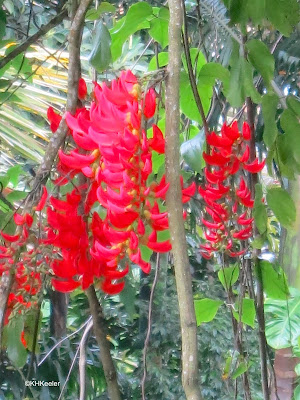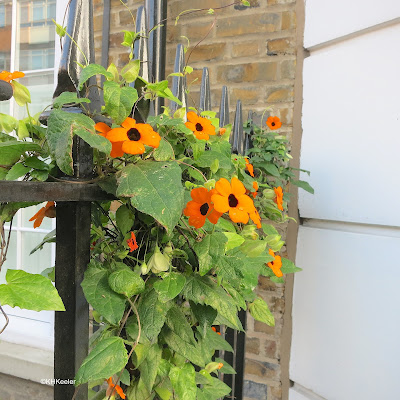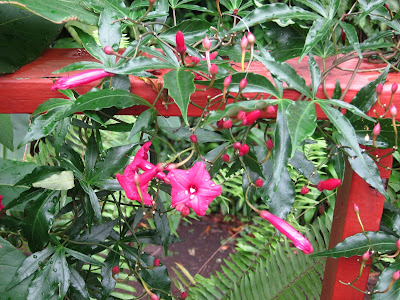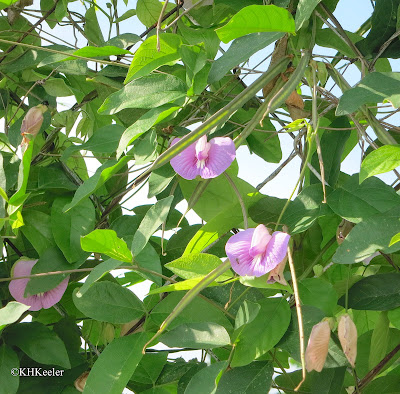We had a blast of sleet and cold rain and now a forecast for rain and cool all week. So I'm posting pictures of tropical vines in flower. All year round, you can visit the tropics and see flowers. Not all these vines bloom year round, but when you see them, wow!
 |
| red jade vine, Mucuna bennettii |
They are more wonderful in real life, with texture and scent, but I can only share photos today, so: enjoy.
Red jade vine, is from southeast Asia (Mucuna bennetti in the pea family, Fabaceae). I saw it in Hawaii. Here's another angle
Red jade vine looks a lot like other pea-family red flowers, but its relatives, jade vines (Strongylodon species) are a rare, unmistakable color. They too are from southeast Asia but planted all over the tropics. (My photos are from Oahu, Hawaii).
 |
| jade vine, Strongylodon species |
Clock vine flower, Thunbergia mysorensis (in the acanthus family, Acanthaceae) is another vine from the Asian tropics with amazing flowers.
 |
| clock vine flower, Thunbergia mysorensis |
Carl Thunberg was a Swedish doctor and botanist (1743-1828) who traveled in South Africa, Indonesia, and Japan. He collected many plants and many are named after him. The genus named for him, Thunbergia, includes some quite spectacular big vines. Below is another one, black-eyed Susan vine, Thunbergia alata, obviously different from the sunflower family blackeyed Susan of the plains (Rudbeckia). From South Africa, black-eyed Susan vine is grown in cool climates as a garden annual. The picture below is from a window box in London in December (mild climate!)
 |
| black eyed Susan, Thunbergia alata |
Another plant group with spectacular flowers are catalpa's viney relatives, vines in the catalpa family, Bignoniaceae. Trumpet vine (Campsis radicans) of eastern North America, now widely planted, is a temperate example. I don't know the name of this multicolored vine from Costa Rica, other than it was in the catalpa family. But very handsome!
 |
| catalpa family tropical vine |
 |
| morning glory, Ipomoea species |
While blue, purple, and white are common, a few morning glories have red flowers. Shown below is one of my favorites called Prince Kuhio vine in Hawaii and Lady Doorly's morning glory in the Caribbean where it is native. It shares the common name cardinal creeper with various red morning glories. The scientific name is Ipomoea horsfalliae. It honors Mrs. Charles Horsfall, and so has a rather rare feminine ending, -ae after the i. (The form is "of horsfall" making it possessive, as in Horsfall's morning glory but to make a possessive after consonants like a double l, Latin puts two i's in the masculine. Hall's bluestem (usually called sand bluestem) is Andropogon hallii. Horsfall's morning glory would be Ipomoea horsfallii, if it referred to Charles Horsfall, but Ipomoea horsfalliae honors Horsfall (female), that is, Dorothy Horsfall, an avid botanist like her husband.)
 |
| Prince Kuhio vine, Ipomoea horsfalliae |
Another great group of vines native to the Americas are the passion flowers. I saw this one blooming in Bali--you can meet them all over the world. Likely it is red passion vine Passiflora racemosa, but there are two or three very similar species.
And finally, a pea vine (pea family Fabaceae), the butterfly pea (Clitoria sp.). I saw this in Panama, but there are similar species native to Asia and to the southern U.S.
 |
| butterfly pea, Clitoria sp. |
 |
| Here's the clock vine, Thunbergia mysorensis reaching down to the ground in south Florida, easy to look closely at. |
Comments and corrections welcome.
Kathy Keeler, A Wandering Botanist
More at awanderingbotanist.com
Join me on Facebook: https://www.facebook.com/AWanderingBotanist


No comments:
Post a Comment